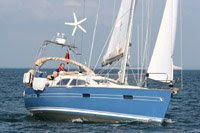
The high part of the Nivernais above Chitry les Mines is both beautiful and impressive. There is a staircase of 16 locks that is run very efficiently in sections of 3 or 4 locks. There are several places to stop between locks although stopping in general is prohibited. There are no real facilities at any of them though. We got through all 16 in one session from 9.00 and lunch with four people on board – one of which helped the lock keepers. It wasn’t even particularly hard work.
At the top lock, you ask the keeper for permission to enter the top section. This is alternate one-way so the keepers at each end coordinate to make sure that nobody meets in the middle. They operate a green/red light so you wait for the green. We didn’t have to wait at all.



Once on the top section you go around a couple of bends and then enter a narrow and increasingly deep cut. The banks are very close and very roughly cut out of the rock leaving a very dangerous looking shoreline. It is all very quiet and almost mysterious shrouded in trees with hanging vines. Then you come to the first (and shortest) tunnel. It is straight but completely un-lit so you can see the end all the time but are completely unable to see the sides next to you. Without torches continuously shone on the banks beside me, I would have been completely unable to steer a good course and would have hit the banks a great deal probably doing a lot of damage to the hull. As it was we negotiated the first one without incident. It was only 250m long but seemed much longer particularly as I felt the need to run at tick-over speed (about 4Kph). The second and slightly longer one was similar and also passed witout incident.
The longest tunnel is just short of a kilometre and fortunately is straight like the others. However the end is so far away that it provides no useful guidance for steering at all. I found it really difficult to keep a straight line and dropped the speed even further. We didn’t touch but got very close several times. Without the torches, we would have had to tow the boat on ropes from the towpath. That could itself have ended in disaster as the tunnel starts with tow paths on both sides but half way through, the right hand one just stops! As you get beyond the half-way mark, there are several vertical shafts. All of them were pouring water down so we would have got drenched if we hadn’t had our wet weather gear on as it had been raining earlier outside.

We finally emerged into the light to find huge lakes which feed the canal on the right. After the entrance to the lake, there is a long causeway separating the canal from the open water. This is an excellent mooring spot although there are no facilities at all. We read from the Navicarte that there are moorings and facilities below the first lock on the downward section so we went through. Big mistake! The banks are all sloping and mostly concrete with no bollards of any description. The only facility is a small cafe which only opens at lunch time! No water, no bread, no nothing.
We spent an uncomfortable night on mooring spikes with our stern propped out by a bit of wood which bumped and ground against the concrete all night.


No comments:
Post a Comment